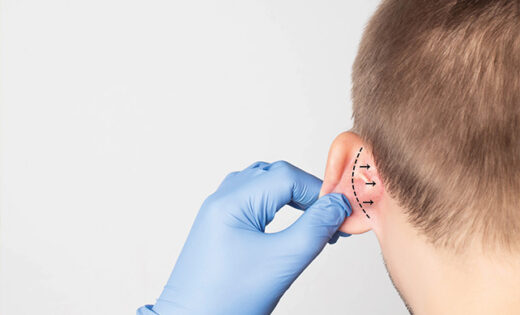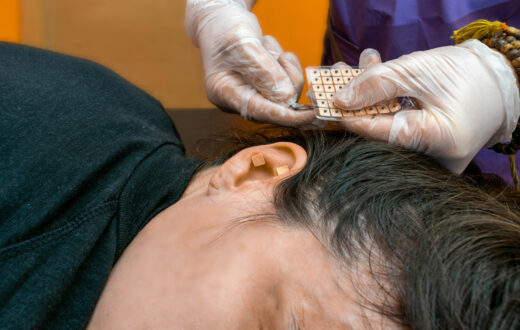
Otoplasty in Turkey
Unlock the Beauty of Your Ears: Otoplasty Redefines Self-Expression!
Why Do People Choose Otoplasty?
There are several reasons someone might consider otoplasty:
- Prominent Ears: Ears that protrude more than 2 cm from the head can be a source of insecurity.
- Asymmetry: Uneven ear shapes or positions can affect facial harmony.
- Birth Defects: Conditions like Stahl’s ear, lop ear, or constricted ear deformities may be corrected surgically.
- Post-Trauma Correction: Injury-related deformities or scarring can be improved through otoplasty.
- Psychosocial Reasons: Many people, particularly children experience teasing or bullying due to ear shape. Otoplasty can significantly improve mental well-being and social confidence.
Otoplasty is often considered an elective cosmetic procedure, but its emotional and psychological benefits are well documented.
Contact Us
You can contact us to benefit from the various advantages and advanced health technology of Erdem Hospital, to ask all the questions you have in mind, and to benefit from our treatments.
Start to complete the form, let us reach you!
After you filled out the form, our medical consultants will get touch in with you to understand your demands.
Please send your photos to medical consultants, our doctors check them.
After all the processes are completed, your treatment will be planned according to the date you are available.
What is Otoplasty?
What Is Otoplasty Surgery?
Otoplasty is a surgical procedure designed to change the shape, position, or size of the ears. It is most commonly performed to correct ears that stick out too far from the head, but it can also address structural defects caused by birth or injury.
The goal of otoplasty is not simply to reduce the size of the ears but to create a more natural and harmonious appearance relative to the rest of the face. This surgery can be performed on one or both ears and is commonly done on children, teenagers, and adults alike.

While much of modern cosmetic enhancement now favors non-invasive solutions, certain conditions still call for a more traditional approach. For individuals with significantly protruding or misshapen ears, otoplasty surgery also known as ear pinning or ear reshaping surgery remains the most definitive and lasting solution.
Whether performed for cosmetic or reconstructive reasons, otoplasty has the power to dramatically improve facial balance and boost self-confidence. In this article, we’ll explore the details of the procedure, who it’s for, how it’s performed, and what to expect before and after surgery.
Ideal Candidates for Otoplasty
Not everyone with concerns about their ears needs surgery, but those who do generally meet the following criteria:
- Children aged 5 or older, whose ears have reached near-adult size.
- Teenagers or adults who are healthy, non-smokers, and without medical conditions that impair healing.
- People with realistic expectations about what the surgery can achieve.
- Individuals who are bothered by how far their ears stick out or the shape/structure of their ears.
It’s important that the decision to undergo surgery especially for children is made thoughtfully and with emotional maturity in mind.
How Is Otoplasty Performed?
Otoplasty is typically performed under local anesthesia with sedation in adults or general anesthesia in children. The entire procedure usually takes between 1 to 2 hours, depending on the complexity.
Here’s a general overview of what happens during the operation:
- Incisions are made behind the ear, within the natural fold where the ear meets the head. In some cases, incisions may be made on the front of the ear, though they are carefully placed to minimize visibility.
- Cartilage reshaping is the main component. The surgeon removes or folds cartilage to achieve the desired contour and reduce protrusion.
- Permanent sutures are used to hold the new shape of the ear in place and to secure the ear closer to the scalp.
- Skin is re-draped, and the incision is closed with fine sutures.
The result is an ear that appears more natural and proportional to the face, typically positioned closer to the head.
Recovery and Aftercare
Post-operative recovery from otoplasty is generally smooth and well-tolerated. Most patients return home the same day and can resume daily activities within a week.
Here’s what recovery typically involves:
- A compression bandage is worn for the first 24 to 48 hours to protect the ears and help them maintain their new position.
- After that, a headband or ear protector may be worn especially at night for several weeks.
- Swelling and bruising are common but subside significantly within the first two weeks.
- Most patients are able to return to school or work within 5 to 7 days.
- Full healing and final results become visible in about 6 weeks, with scars continuing to fade over the next few months.
Your surgeon will provide instructions on how to sleep, clean the area, and monitor for signs of complications.
Risks and Considerations
As with any surgery, otoplasty carries some risks. However, when performed by an experienced specialist, complications are rare. Possible risks include:
- Infection
- Bleeding
- Asymmetry or overcorrection
- Unfavorable scarring
- Temporary numbness
- Suture extrusion (stitches surfacing through the skin)
Careful planning, proper technique, and post-operative follow-up are key to minimizing these risks.

What Can You Expect?
Otoplasty offers permanent results. Once the ears are healed, they retain their new shape and position for life. Patients frequently report an improved sense of self, reduced anxiety in social situations, and an enhanced ability to wear hairstyles that previously made them feel self-conscious.
Many adults say they wish they’d had the surgery earlier. For children, undergoing otoplasty before starting school can help prevent bullying and boost early confidence.

Is Otoplasty Covered by Insurance?
In most countries, otoplasty is considered a cosmetic procedure and is not covered by insurance. However, if the surgery is deemed medically necessary for instance, in cases of congenital deformities or injury some insurance plans may offer partial reimbursement. It’s always best to consult with your healthcare provider and surgeon about the financial aspects.
Otoplasty in Turkey
Medical tourism has made otoplasty more accessible than ever. Turkey, in particular, has become a sought-after destination for ear surgery due to:
- Highly trained plastic surgeons
- Accredited hospitals with modern surgical infrastructure
- Short waiting times
- Affordable pricing, often 50–70% lower than in the UK or US
Patients from around the world are traveling to facilities like Erdem Hospital in Istanbul, which combines over 37 years of medical expertise with personalized patient care. At Erdem Hospital, international patients benefit from English-speaking coordinators, pre-travel consultation, and post-operative support designed for convenience and comfort.
Whether for children or adults, otoplasty at Erdem Hospital is performed with meticulous planning, safety, and a deep respect for the emotional significance of the surgery.

Is Otoplasty Right for You?
Ear shape may seem like a small detail, but for many people, it’s a source of lifelong insecurity. Otoplasty offers a safe, permanent, and highly satisfying solution to those who feel emotionally burdened by prominent or asymmetrical ears.
If you're looking for a transformative procedure that delivers natural results and lasting confidence, otoplasty surgery is worth considering. With a skilled surgeon and thoughtful aftercare, you can expect not just a change in how you look but how you feel in every photograph, meeting, and mirror.
Whether you’re considering ear correction for yourself or your child, the first step is a consultation with a qualified specialist. Your journey toward confidence and facial harmony could be closer than you think.
Otoplasty Methods
Otoplasty Cost in Turkey
Erdem Hospital offers high-level service under the most favorable conditions. With an online free consultation, the price is determined after the treatment recommended by our doctors. Our prices are offered in all-inclusive packages. All services mentioned below will be included in the price.
- Free consultation
- Premium accommodation
- Pre/post-operative testing
- Cost for laboratory
- Medication and Equipment
- All round VIP transfer
- 7/24 Support
- Assistants speak English
Before Otoplasty Operation
Before otoplasty, the patient's medical history is carefully taken. If there are regular medications, chronic diseases, or previous surgeries, the patient should inform the doctor. After the physical examination, photographs of the ears are taken and the patient's expectations are taken. If it is decided that s/he is a suitable candidate for otoplasty, the patient is asked to stop using aspirin, anti-inflammatory drugs, and herbal supplements that may increase bleeding before the operation. Smoking can slow blood flow and the healing process. If the patient smokes, it is recommended to stop smoking before the surgery and during the recovery period.
After Otoplasty Operation
After prominent ear surgery, the patient's ears are covered with a bandage for protection and support. As a result, some discomfort and itching may be felt. Localized pain and swelling may occur in and around the ears on the first day after surgery. In this case, pain relievers can be used as recommended by the doctor. Although it is recommended to rest for the first week, care should be taken not to stay still to maintain blood draw. When lying down, a position with the head up should be preferred. No pressure should be applied to the ears, patients should not be lying on their sides, if possible, loose-collared or buttoned tops should be preferred. It is normal for the ears to be swollen and red when the bandages are removed a few days after otoplasty. It is recommended to wear a loose headband that covers the ears at night for 2-6 weeks. This prevents the ears from bending forward when turning in bed. If a self-dissolving suture is used, there is no need for suture removal. Otherwise, the stitches should be removed within the time specified by the doctor. There is no problem in taking a bath after the bandages are removed after the surgery, but the back of the ear should not be left wet after the bath. The creams recommended by your doctor should be used as recommended for the scar areas. Thus, the formation of traces will be prevented. Although the bandages are removed at the end of the first 3 days, it is important to wear the bandage at night for the first week to protect the ears, especially at night, and not to open them by putting on the pillow during sleep. The first dressing made during the surgery is checked at the time prescribed by your doctor. After the dressing area is checked, the bandage is used in line with your doctor's recommendations. Heavy sports activities should be avoided for 2 months after the surgery. During this period, walking and light-paced sportive activities can be done unless there is an activity that will force the ear. The use of cigarettes and other tobacco products may cause tissue circulatory disorders and increase the possibility of adverse conditions such as infection, wound separation, and thick scars due to their effects that impair wound healing. It is essential to shield the ear from hits.
Otoplasty Process
General
1-2 Hours
4 Days
1 Week
Otoplasty in Turkey FAQ
If you don't see an answer to your question, you can send us an email from our contact form.
For the tests and examinations, you need to undergo before the operation, it would be better for the patients to be in Istanbul a few days before the surgery.
Otoplasty surgery typically lasts 1.5 hours. The entire process—preparation, surgery, and recovery—usually takes one week. Therefore, we can predict that you will stay in Istanbul for about 5 days. You can extend your stay to view Istanbul's ancient sites and the lovely Bosphorus.
Since it is a surgical intervention, the results will be life-long.
The experts state that the best age for an application as otoplasty is around 5 years old.
You will not feel anything throughout the surgery, but there may be some discomfort and maybe itching after the surgery.
There may be some slight changes as the age develops. But a complete return is rarely seen.
Children can feel more secure about how they look by having otoplasty (or ear surgery) to fix cosmetic abnormalities affecting the ears. As more parents become aware of the effect that children's ears might have on their developing self-esteem, otoplasty has grown in popularity in recent years.
For six to eight weeks following ear surgery, most otoplasty patients wear the headband when sleeping and participating in sports.
Your ears will be numb for two to three months following otoplasty. It's wonderful that you don't feel any pain, but it also means that you might not notice the consequences of frostbite and burning.
It should be worn at night and during the evening for the following five weeks or so. If you choose not to wear it, there is undoubtedly a higher risk of unintentional ear trauma, especially when sleeping, which could affect your outcome.
It is not observed that an otoplasty operation has affected hearing.
You can begin walking right away. In two weeks, you can start working out and/or lifting. To prevent the healing process from being hampered, you should also make sure you refrain from any strenuous exercises or contact sports for a few weeks.